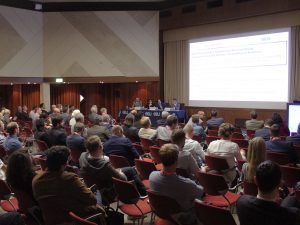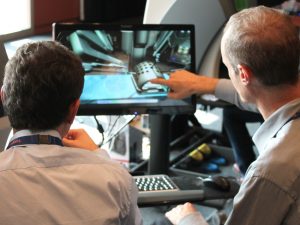The EAU Robotic Urology Section prides itself on each year demonstrating the newest technology related to its field, as well as offering training, curricula and invaluable surgical know-how of the expert speakers at its meetings.
For the third year in a row, ERUS has also held its Technology Forum, a two-hour look at the robot-related tech that manufacturers have in the pipeline. Wednesday afternoon saw a packed theatre at the Chanot Congress Centre in Marseille, full of surgeons with their eyes on the future.
Internet of Skills
Prof. Prokar Dasgupta first held a talk that served as an overview of new and emerging technology from the surgeon’s point of view. He saw great potential in haptics, finding scope for improvement in the current solutions. He shared his experiences with prototypes of the so-called “soft robot” that make use of granular jamming to remain as flexible as possible and firming when necessary.
There have been developments in tablet-guided robotics, combining imaging data and 3D reconstructions that allow the surgeon to virtually see through the patient’s skin. When combined with 3D printing, surgeons can have an exact replica of their patient’s prostate, bladder or kidney in their hands prior to the surgery.
A completely new concept is made possible by 5G transmission: the internet of skills. They allow the patient parameters to be transferred to a surgeon anywhere on earth. Lag can be reduced to <10ms, making it almost realtime. A pilot project is currently ongoing, with a transmitter on the roof of King’s College. “This has great potential to democratize surgery,” Dasgupta pointed out.
“Ultimately, I’m not interested in the latest generation of 3D vision, or extra wrist action for robots. I’m interested in reducing costs, in new uses of data, and improved connectivity.”
Manufacturers
Prof. Dasgupta also spoke on his experiences with the on CMR Surgical Versius robot. He described it as the first credible British-developed robot since Wickham’s PROBOT in the early 1990s. A video of the first demonstration on a cadaver followed. The system is completely controlled by hand, giving great flexibility to the surgeon. There were many questions from the audience about the new system, particularly the exact mechanics and how it compares to existing systems.
Mrs. Leila Bahreinian presented the plans of the Medicaroid company, a joint venture by Kawasaki Heavy Industries and Sysmex headquartered in Japan. The company combines decades of experience in robot manufacturing and in medical diagnostic equipment, aiming to “humanize the robot.” Experience with human-supervised autonomy in assembly lines and the use of existing Sysmex and Kawasaki support networks give Medicaroid an advantage when it enters the market for medical robots in the coming years.
Prof. Mottrie, ERUS chairman added to the discussion after Mrs. Bahreinian’s talk by pointing out that medical robotics can reach beyond surgical systems but also automate diagnostics and other smaller procedures. Talking about the scope for several companies sharing the market for surgical robots, Prof. Dasgupta pointed out that our perspective was one skewed by wealth and priviledge. There was still a huge untapped market of surgeons who cannot afford the current robotic systems.
The session concluded with Dr. Jaime Wong speaking on behalf of Intuitive and Dr. Sebastien Crouzet on his experiences with the upcoming Titan Medical SPORT robotic system. Dr. Wong shared some older Intuitive designs, with table-mounted arms and elevated, open screens like the newly emerging systems tout as advantages. He said that these designs were considered but ultimately rejected after research, trials and consultation with surgeons.





